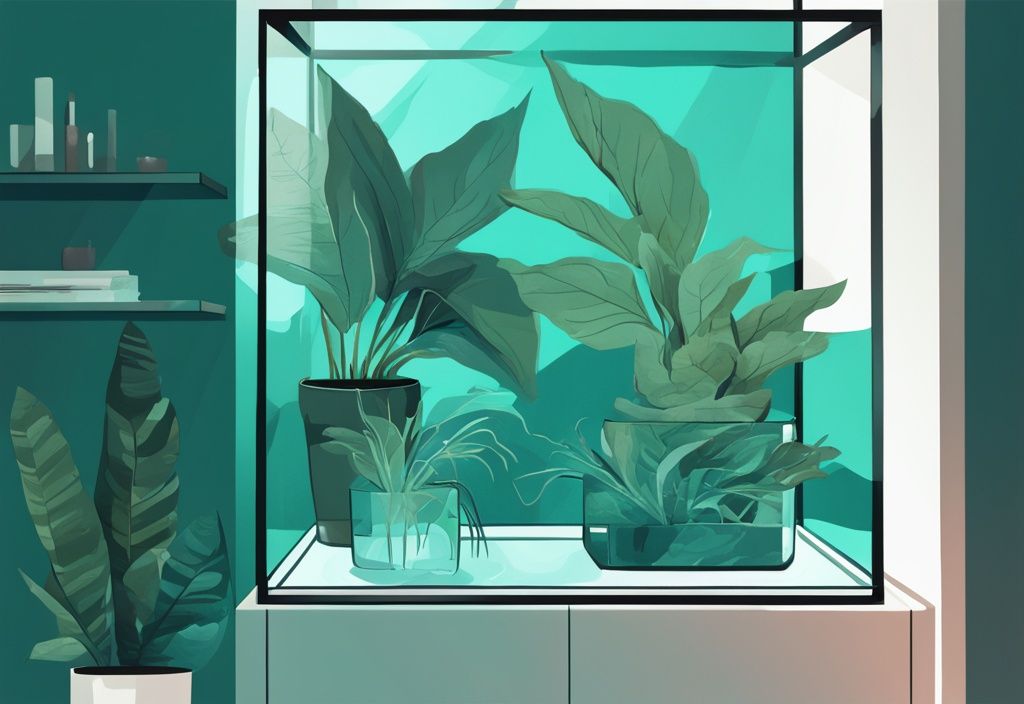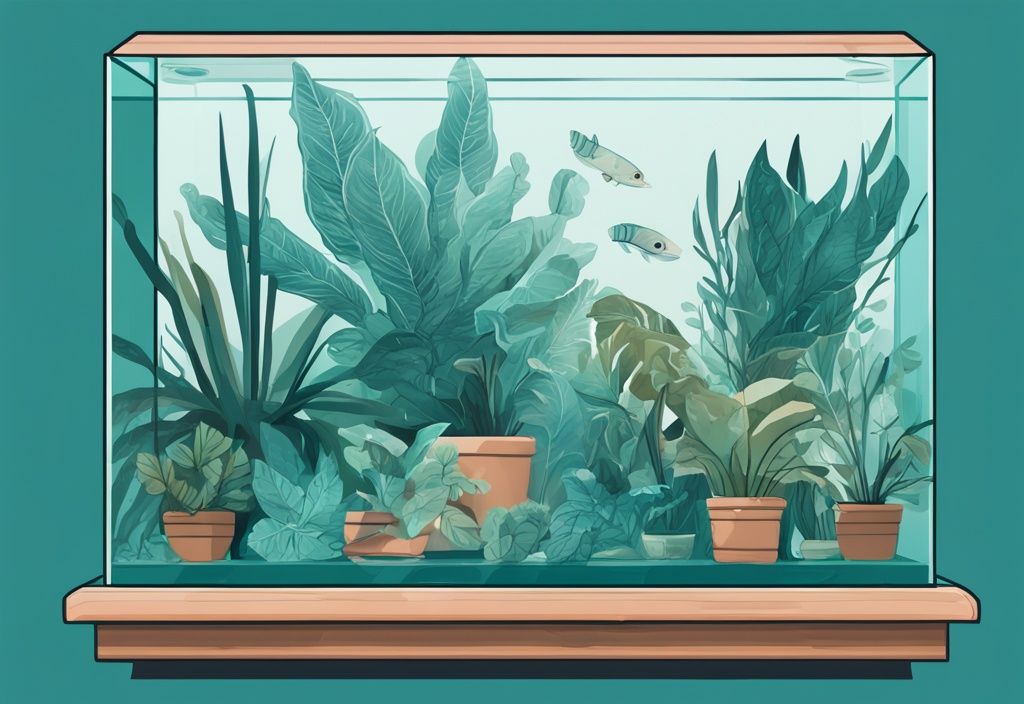Did you know house plants can be your aquarium’s secret weapon? As an experienced marine biologist, I’ve repeatedly seen how these everyday plants can solve common problems that plague even the most dedicated aquarists, from pesky algae blooms to water quality issues. And the cherry on top? They provide tremendous aesthetic appeal.
This guide dives into how the inclusion of house plants into your aquarium can significantly improve both its health and beauty. We’ll explore how they act as unsung heroes, serving as natural filters and enhancing oxygen levels, critical for your aquatic life’s wellbeing.
Eager to revolutionize your fish tank setup? Get ready to unearth the phenomenal potential of house plants. Let’s breathe new life into your aquarium, together!
Why You Should Use House Plants in Your Aquarium
House plants in aquariums offer numerous benefits, from improved water quality to enhanced aesthetics. Understanding these advantages can help aquarists create healthier and more visually appealing aquatic environments.
Improved Filtration and Healthier Environment
House plants in aquariums act as natural filters, significantly enhancing the water quality. They efficiently reduce nitrates and other harmful chemicals, such as ammonia and phosphates, which are common byproducts of fish waste. By absorbing these nutrients, house plants promote their growth while simultaneously cleansing the water, which is crucial as plants play an essential role in aquatic ecosystems, as highlighted in this article about the importance of plants in aquatic environments here.
This dual benefit facilitates clearer and healthier water conditions, reducing reliance on artificial filtration systems. Another key advantage is enhanced oxygenation through photosynthesis, which helps create a robust and breathable environment for aquatic life. This process ensures that fish and other aquatic organisms thrive in an ecosystem that mimics their natural habitats.
Nutrient Absorption: A Perk of House Plants
Utilizing house plants in an aquarium offers a natural and efficient way to manage nutrient levels. By absorbing excess nutrients, house plants help prevent problematic algae blooms that can cloud the water and create imbalances. This nutrient absorption maintains balanced water chemistry, thereby reducing the need for chemical treatments and interventions.
The roots of these plants are particularly adept at taking up nitrate, ammonia, and phosphates—compounds that, in high concentrations, can be toxic to fish. By integrating house plants, aquarists can ensure a more stable and self-sustaining aquatic environment, benefiting both the flora and fauna within the aquarium.
Boosting Aesthetics with House Plants
Adding house plants to an aquarium is a simple yet effective way to enhance its visual appeal. The lush greenery and variety of these plants create a vibrant and dynamic look that can transform a simple tank into a stunning underwater garden.
Beyond aesthetics, house plants help in creating natural habitats and hiding spaces for fish, making the aquarium more engaging and closer to their native environments. Furthermore, the combination of terrestrial and aquatic plants allows for more intricate aquascaping designs, adding depth and diversity to the overall layout. These elements not only make the aquarium more attractive but also provide a more enriching and balanced habitat for its inhabitants.
By integrating house plants into your aquarium, you can achieve significant improvements in water quality, nutrient balance, and aesthetic appeal. This holistic approach not only benefits the health and well-being of the aquatic life but also offers aquarists an opportunity to create visually stunning and ecologically balanced aquatic environments.
The Best House Plants for Aquariums
When it comes to integrating house plants in aquariums, the choices can be diverse and enriching.
From beginner-friendly options to more advanced picks, these plants not only elevate the aesthetic appeal but also contribute to the health and balance of your aquatic ecosystem.
Top Picks for Beginners: Easy-to-Care House Plants in Aquariums
Pothos (Devil’s Ivy): Pothos is a remarkable addition to any aquarium due to its versatility and adaptability. Known for its prowess in nutrient absorption, it efficiently removes nitrates and other harmful chemicals from the water. Its resilience in various conditions makes it an excellent choice for beginners.
Spider Plants (Chlorophytum): A splendid option for those new to aquarium plants, spider plants flourish in high-humidity environments. Their submerged roots are easy to manage, and they add a pleasing visual appeal while contributing to a cleaner tank environment.
Peace Lilies: These plants offer both beauty and functionality. Able to grow with their roots submerged, Peace Lilies are ideal for aquarium settings. Their lush foliage and striking white blooms provide an aesthetic lift while requiring minimal care.
Lucky Bamboo: Revered for its simplicity and low maintenance, Lucky Bamboo thrives with submerged roots, making it perfect for beginners. It adds a natural look to the aquarium while promoting a healthier environment.
Advanced Choices: Unique House Plants for Aquariums
For those ready to dive deeper, these advanced options bring unique visual elements and require a bit more attention to care.
Monstera (e.g., Deliciosa, Adansonii): Monstera species are celebrated for their distinctive leaf patterns and thrive in the humid atmosphere of an aquarium. They add a dramatic touch, creating a naturalistic setting for both fish and plants. Just monitor humidity levels carefully.
Philodendrons: Particularly vine species, philodendrons with submerged roots can expand extensively, offering unique aesthetic appeal. They enrich the tank environment with their lush growth and vibrant colors, though some species may require monitoring for potential toxins.
Syngoniums: With their attractive foliage, Syngoniums grow emersed with submerged roots, enhancing visual interest above water while aiding in water purification. They demand slightly more care in terms of placement but offer considerable visual rewards.
Calathea: Known for their vibrant, decorative leaves, Calatheas require careful monitoring of humidity and water quality. Their inclusion can make the tank exceptionally striking, though they necessitate meticulous care.

Incorporating these house plants in aquariums boosts aesthetic value while fostering a healthier aquatic environment. Each plant contributes uniquely to maintaining a balanced ecosystem, ensuring a harmonious life for both fish and plants.
Steps to Incorporate House Plants into Your Aquarium
How to Get Started: Using HOB Filters and Plant Holders
House plants in an aquarium can significantly improve both water quality and aesthetics. One highly effective method to incorporate house plants is by utilizing Hang-On-Back (HOB) filters. These filters not only purify the water but also provide an ideal environment for plant roots.
By planting in the filter media bed, the roots are constantly bathed in nutrient-rich water. This enhances plant growth and helps in the absorption of harmful substances like nitrates and phosphates. Imagine it as a natural purification system working seamlessly within your aquarium.
Plant holders are another practical tool for integrating house plants into your setup. Designed to sit on the aquarium rim, these holders provide easy access for roots to reach the water while keeping the foliage above the waterline. This ensures that plants receive sufficient CO2 from the air, an essential component for photosynthesis.
The strategic placement of plant holders can maximize both the functional and aesthetic benefits. It creates an attractive and healthy environment for your aquatic life, blending both beauty and practicality.
Creating an Idyllic Setup with Fish Breeder Boxes and Glass Plant Cups
To incorporate house plants into your aquarium in a versatile and stable manner, consider using fish breeder boxes. These boxes serve not only as isolated environments for breeding but can also hold planting media, effectively turning them into extra filtration units.
By placing nutrient-absorbing plants in these boxes, you can enhance overall water quality while providing a separate space for young fish or sensitive species. This multi-functional approach enriches the ecosystem of your aquarium.
Glass plant cups offer another innovative solution. These cups, which attach to the aquarium wall via suction cups, keep plants in place with their roots submerged and leaves above the water. This setup is particularly effective for house plants that require emersed growth due to their need for atmospheric CO2.
Additionally, this allows for more creative and versatile design options, enabling you to arrange plants at different heights and locations around the aquarium. You can think of it as adding layers of elegance and functionality to your underwater world.
Incorporating these methods ensures the stability of house plants in aquariums while offering a visually appealing and functionally enriching setup. The combination of plants and aquatic life in a well-thought-out arrangement can lead to a thriving, balanced ecosystem.
How to Grow House Plants in an Aquarium Successfully
Growing house plants in an aquarium is an enriching experience that combines aquatic beauty with the natural elegance of house plants. To make this endeavor successful, understanding the different growth methods and propagation techniques is crucial. Here’s a detailed guide.
The Big Decision: Emersed vs. Submerged Growth
Growing house plants in an aquarium requires a critical decision between emersed and submerged growth.
Emersed growth, where the plant’s roots are submerged while the foliage stays above water, is generally more effective for most house plants. This is because the aerial parts of the plant have access to higher CO2 levels in the air, enhancing photosynthesis and overall health. Emersed growth is ideal for species like Pothos and Spider Plants that thrive in humid conditions with their roots submerged.
Submerged growth, on the other hand, involves immersing the entire plant—roots and foliage—in water. While this method suits aquatic-adapted plants, it demands regular monitoring to prevent rot and ensure cellular respiration. Submerged growth can be a good option for hardier species such as Peace Lilies and Lucky Bamboo but requires vigilant maintenance to keep water quality in check.
Choosing the right method depends on the specific plant species and your capacity for ongoing care. Always consider each plant’s natural habitat and requirements when deciding between emersed and submerged growth.
Hit the Ground Running: Propagating and Rooting House Plants
Propagating house plants in an aquarium starts with identifying suitable plants and their root nodes. These nodes are critical for root development, so locate them carefully on the plant stems. Use sterilized scissors to cut the stem just below the node, ensuring a clean and healthy cutting.
Next, submerge only the end of the cutting in water. This submersion technique encourages root development by keeping the node in nutrient-rich water without drowning the entire cutting. As roots begin to form, maintain proper humidity around the cutting. Use a makeshift humidity dome or a clear plastic cover to create a moist environment conducive to root growth.

Avoid placing the cuttings in direct sunlight. Intense light can foster algae growth on the cuttings, complicating their rooting process. Indirect light is sufficient to support photosynthesis without encouraging unwanted algae. Regularly change the water to prevent stagnation and provide fresh nutrients.
By following these careful but straightforward steps, you can successfully propagate and root house plants in your aquarium, leading to a thriving aquatic environment.
Mastering Maintenance of Aquarium House Plants
Properly caring for house plants in an aquarium involves understanding various aspects, which we’ll explore in the following sections.
The Art of Monitoring Plant Growth
Meticulously monitoring plant growth is essential for maintaining a healthy aquarium ecosystem. Regularly check for new growth, decay, or disease to detect issues early. Early intervention prevents disease spread and keeps plants vital and flourishing.
Trimming overgrown plants is a crucial aspect of maintenance. It helps prevent overcrowding and ensures optimal light penetration. Overgrowth can overshadow smaller plants, depriving them of necessary light, which can stifle growth. Regular trimming ensures all plants receive the light they need to thrive.
Observing the overall health of both plants and fish sustains an ecological balance. Healthy plants are a sign of a stable environment, whereas signs of stress or illness in plants can indicate underlying issues affecting fish. Close monitoring fosters a harmonious aquarium that supports both plant and animal life.
Maintaining Balanced Water Temperature and pH Levels
Ensuring the right water temperature is paramount for the well-being of house plants in an aquarium. Different plants and fish have specific temperature preferences, so adjusting the water temperature accordingly is important. A reliable thermometer helps make precise adjustments to maintain the ideal range.
Regular testing and adjustment of pH levels are vital. Various factors like fish waste and plant decay can cause pH fluctuations. Using a pH testing kit helps maintain the right balance. Make adjustments gradually to avoid shocking the ecosystem, as sudden changes can stress both aquatic plants and fish.
Attention to water temperature and pH levels ensures a stable environment for house plants in aquariums, supporting robust plant growth and overall health.
Handling Fertilizers and Regular Cleaning Safely
Using the right fertilizers is crucial for the healthy growth of house plants in aquariums. Select aquarium-safe fertilizers to avoid harmful effects on fish and other aquatic organisms. Follow the recommended dosage and schedule to provide nutrients without causing nutrient buildup, which can lead to algae blooms and other issues.
Regular cleaning of the aquarium is another fundamental maintenance task. Remove decaying plant material and algae to maintain a clean environment. Decaying plants can release harmful substances into the water, affecting both plants and fish. Regular cleaning mitigates these issues, promoting a healthier ecosystem.
Carefully managing fertilizers and maintaining a clean aquarium fosters a thriving environment for house plants in aquariums. This diligence contributes to sustained aesthetic and ecological benefits, making your aquarium an engaging and vibrant habitat. For those interested in expanding their aquatic knowledge, our guide on saltwater aquarium fish for beginners offers valuable insights and tips to create a balanced ecosystem.
Overcoming Challenges in Aquarium House Plant Care
Ensuring the health of house plants in aquarium settings involves specific strategies and practices that address the common issues faced by aquarists. This section dives into two core areas: combatting plant diseases and preventing water stagnation and overcrowding.
Combatting Plant Diseases: Critical Prevention Tips
Keeping house plants in aquarium environments presents unique challenges, particularly in preventing diseases. Regularly inspecting your plants is crucial. Look closely for any signs of disease or pests, such as discolored leaves, unusual spots, or wilting. By detecting issues early, you can remove affected parts promptly, preventing the spread of infections to other plants.
Quarantining new plants before introducing them into the aquarium is another effective prevention method. This practice isolates potential carriers of diseases and pests, giving you the opportunity to treat any problems before they can spread.
Maintaining clean water conditions is essential to the health of both fish and plants. Regular water changes, proper filtration, and avoiding overfeeding will help minimize the nutrients that contribute to disease growth, thus reducing the risk of plant infections.
Preventing Water Stagnation and Overcrowding
Proper water circulation is fundamental to preventing stagnation when housing house plants in aquarium setups. Ensure that your tank is equipped with effective filters and air pumps. These tools promote water movement, enhancing oxygenation and distributing nutrients evenly throughout the aquarium.
Avoiding overcrowding is equally important. Overcrowded plants can hinder growth and lead to competition for nutrients, making both plants and fish unhealthy. Regularly monitor plant growth and be ready to prune or rehome plants as needed to maintain a balanced environment.
Choosing the right aquarium size is essential for accommodating both house plants and aquatic life without leading to overcrowding. Consider the mature size of your plants and fish when selecting your tank to ensure ample space for healthy growth and movement. This consideration helps create a balanced, thriving aquatic ecosystem.

Decorating with House Plants for an Enchanting Aquarium
Creating an enchanting aquarium setup with house plants involves combining a mix of plant species and hardscape materials. You can include rocks, driftwood, and other decorative elements to form a visually appealing aquatic environment. Using a combination of different plant species not only enhances the aesthetic charm but also mimics a natural habitat that benefits aquatic life.
Incorporating layers and levels within your aquarium design adds depth and dimension. Position taller plants towards the back and shorter ones in the front to create a tiered effect. This layering technique not only creates an engaging visual experience but also provides varied hiding and swimming spaces for fish, promoting their well-being.
Experimentation with plant placements is essential to achieve a cohesive and functional design. Arrange plants of varying heights and textures to create contrast and visual interest. Adding house plants around the edges and using hardscape elements like stones and wood ensures both aesthetic appeal and practical benefits, giving fish places to explore and hide.
Level Up: Aquascaping with House Plants
Aquascaping is an art that blends plant biology with design principles to create a harmonious aquatic display. To level up your aquarium with house plants, consider artistic principles such as focus, balance, and harmony. These principles, when combined with an understanding of plant needs, result in a visually stunning and thriving aquarium.
Using the right substrates, fertilizers, and CO2 systems helps in boosting the growth and appearance of your house plants in the aquarium. A nutrient-rich substrate supports healthy root development, while regular fertilization ensures the plants receive the necessary nutrients. CO2 systems can optimize plant growth, especially for more advanced aquascaping designs.
Maintenance is crucial to sustaining the beauty and health of your aquascape. Regularly trim and prune plants to manage growth and prevent overcrowding. This keeps the aquarium’s appearance neat and ensures optimal light penetration for all plants. Adjust your setup as needed, taking into account the growth patterns and requirements of your house plants in aquarium settings to maintain a balanced and enchanting aquascape over time.
FAQ: House Plants in Aquariums
Incorporating house plants into your aquarium can create a lush, thriving ecosystem. Here are some common questions and expert insights to help you get started:
Can house plants survive fully submerged in aquarium water?
Most house plants can handle having their roots submerged, but their foliage generally needs to stay above water. If leaves are submerged, they might rot because they cannot access CO2 efficiently underwater. Keeping the foliage above the surface allows plants like Pothos and Peace Lilies to flourish, contributing to a balanced aquatic environment. Imagine the roots as snorkels diving into an underwater world, while the leaves bask in fresh air, ensuring the plant receives ample CO2.
How long does it take for house plants to root in aquariums?
Rooting times depend on the plant species. On average, house plants will establish roots within 1-4 weeks in an aquarium environment. Spending that time observing the roots can be like watching a mini nature documentary unfold in your tank. Ensure your plants have optimal conditions—good water quality, adequate light, and stable temperatures—to encourage quicker rooting. For instance, Pothos may root faster than others due to their adaptive nature.
Which house plants are best for beginners in aquariums?
If you’re new to adding house plants to your aquarium, start with hardy species. Pothos, Spider Plants, and Lucky Bamboo are fantastic choices. These plants are resilient and require minimal maintenance. Their adaptability makes them like the all-weather friends of the plant world, ensuring they thrive even if you’re still getting the hang of managing an aquarium. They also help absorb excess nutrients, keeping your aquarium’s ecosystem balanced and vibrant. This not only benefits the plants but also the fish and other inhabitants of your tank.
Conclusion
Incorporating house plants in your aquarium brings a multitude of benefits, making them an essential addition to any aquarist’s setup. House plants in aquariums contribute to natural filtration, absorbing harmful chemicals and nutrients from fish waste, which results in cleaner, healthier water. This natural filtration process minimizes the need for chemical interventions, creating a more sustainable environment for your aquatic life.
Moreover, house plants significantly enhance the aesthetic appeal of your aquarium. Their greenery and variety create a visually engaging and natural habitat for fish, making the aquarium a stunning focal point in any room. From the ease of care species like Pothos and Lucky Bamboo, to more advanced choices like Monstera and Calathea, there’s a wide range of plants that cater to different skill levels and design preferences.
For those dealing with persistent algae issues, learn how to effectively manage algae in a fish tank to maintain a healthy and beautiful aquarium environment.
Encouraging experimentation with diverse plant species and setups can yield rewarding results. By mixing different house plants, you not only boost the visual complexity of your aquarium but also improve its ecological balance, creating a dynamic environment that supports vibrant aquatic life.
The ecological improvements brought by house plants in aquariums cannot be overstated. Enhanced oxygenation through photosynthesis provides a healthier atmosphere for fish, and the absorption of excess nutrients helps prevent algae blooms. These benefits create a more balanced and thriving aquatic ecosystem.
Overall, the integration of house plants in aquariums offers both aesthetic and environmental advantages, making them a valuable addition for any aquarium enthusiast. Dare to experiment, and you’ll likely discover the transformative impact these plants can have on your aquatic setup.
